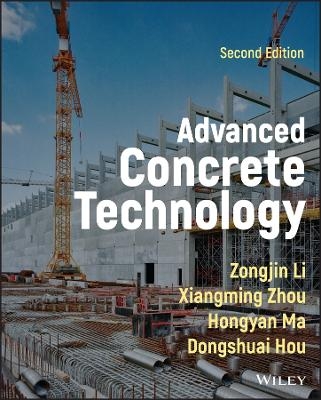
Advanced Concrete Technology
John Wiley & Sons Inc (Verlag)
978-1-119-80625-7 (ISBN)
In the newly revised second edition of Advanced Concrete Technology, a distinguished team of academics and engineers delivers a state-of-the-art exploration of modern and advanced concrete technologies developed during the last decade. The book combines the essential concepts and theory of concrete with practical examples of material design, composition, processing, characterization, properties, and performance.
The authors explain, in detail, the hardware and software of concrete, and offer readers discussions of the most recent advances in concrete technology, including, but not limited to, concrete recycling, nanotechnology, microstructural simulation, additive manufacturing, and non-destructive testing methods.
This newest edition of Advanced Concrete Technology provides a sustained emphasis on sustainable and novel technologies, like new binders, 3D printing, and other advanced materials and techniques. Readers will also find:
A thorough introduction to concrete, including its definition and its historical evolution as a material used in engineering and construction
In-depth explorations of the materials for making concrete and the properties of fresh concrete
Comprehensive discussions of the material structure of concrete, hardened concrete, and advanced cementitious composites
Fulsome treatments of concrete fracture mechanics, non-destructive testing in concrete engineering, and future trends in concrete
Perfect for undergraduate and graduate students studying civil or materials engineering—especially those taking classes in the properties of concrete or concrete technologies—as well as engineers in the concrete industry. Advanced Concrete Technology, 2nd Edition will also earn a place in the libraries of civil and materials engineers working in the industry.
Zongjin Li, PhD, is a Chair Professor in the Institute of Applied Physics and Materials Engineering at University of Macao. He led a China National Basic Research Project (973), ‘Basic Study of Environmental Friendly Contemporary Concrete’ from 2009-2013 as Chief Scientist. Xiangming Zhou, PhD, is a Professor in the Department of Civil & Environmental Engineering at Brunel University in London, UK. Hongyan Ma, PhD, is an Associate Professor in the Department of Civil, Architectural and Environmental Engineering at the Missouri University of Science and Technology in the United States. Dongshuai Hou, PhD, is a Professor in the Department of Civil Engineering at the Qingdao University of Technology in China.
Preface
1 Introduction to Concrete
1.1 Concrete Definition and Historical Development
1.2 Concrete as a Structural Material
1.3 Characteristics of Concrete
1.4 Types of Concrete
1.5 Factors Influencing Concrete Properties
1.6 Approaches to Study Concrete
Discussion Topics
References
2 Materials for Making Concrete
2.1 Aggregates for Concrete
2.2 Cementitious Binders
2.3 Admixtures
2.4 Water
Discussion Topics
Problems
References
3 Fresh Concrete
3.1 Introduction
3.2 Workability and Rheology
3.3 Mix Design
3.4 Manufacture of Concrete
3.5 Delivery of Concrete
3.6 Concrete Placing
3.7 Curing of Concrete
3.8 Early-Age Properties of Concrete
Discussion Topics
Problems
References
4 Materials Structure of Concrete
4.1 Introduction
4.2 Classification of Materials Structural Levels
4.3 Structure of Concrete at Nanometer Scale: The C–S–H Structure
4.4 Structure of Concrete at the Micro-Scale
4.5 The Transition Zone in Concrete
4.6 Nano- and Micro-Structural Engineering
Discussion Topics
References
5 Properties of Hardened Concrete
5.1 Strengths of Hardened Concrete
5.2 Stress–Strain Relationship and Constitutive Equations
5.3 Dimensional Stability—Shrinkage and Creep
5.4 Durability
Discussion Topics
Problems
References
6 Advanced Cementitious Composites
6.1 Fiber-Reinforced Cementitious Composites
6.2 High-Strength Cementitious Composites
6.3 Ultra-High-Strength Concrete
6.4 Polymers in Concrete
6.5 Shrinkage-Compensating Concrete
6.6 Self-Compacting Concrete
6.7 Engineered Cementitious Composite
6.8 Confined Concrete
6.9 High-Volume Fly Ash Concrete
6.10 Structural Lightweight and Heavyweight Concrete
6.11 Sea Sand and Sea Water Concrete
6.12 The 3D Printed Concrete
Discussion Topics
Problems
References
7 Concrete Fracture Mechanics
7.1 Introduction
7.2 Linear Elastic Fracture Mechanics
7.3 The Crack Tip Plastic Zone
7.4 Crack Tip-Opening Displacement
7.5 Fracture Process in Concrete
7.6 Nonlinear Fracture Mechanics for Concrete
7.7 Two-Parameter Fracture Model
7.8 Size Effect Model
7.9 The Fictitious Model by Hillerborg
7.10 R-Curve Method for Quasi-Brittle Materials
7.11 Double-K Criterion
7.12 The Application of Fracture Mechanics in the Design Code of Concrete Structures
Discussion Topics
Problems
References
8 Nondestructive Testing in Concrete Engineering
8.1 Introduction
8.2 Review of Wave Theory for a 1D Case
8.3 Reflected and Transmitted Waves
8.4 Attenuation and Scattering
8.5 Main Commonly Used NDT-CE Techniques
8.6 Noncontacting Resistivity Measurement Method
8.7 An Innovative Magnetic Corrosion Detection Transducer
Discussion Topics
Problems
References
9 The Future and Development Trends of Concrete
9.1 Sustainability of Concrete
9.2 Deep Understanding of the Nature of Hydration
9.3 Integrated Materials and Structural Design
9.4 High-Tensile-Strength and High-Toughness Cement-Based Materials
9.5 Application of Nanotechnology in Concrete
9.6 Data Science and Artificial Intelligence in Concrete Technology
References
Index
| Erscheinungsdatum | 02.09.2022 |
|---|---|
| Verlagsort | New York |
| Sprache | englisch |
| Maße | 188 x 239 mm |
| Gewicht | 1383 g |
| Themenwelt | Technik ► Bauwesen |
| Technik ► Maschinenbau | |
| ISBN-10 | 1-119-80625-9 / 1119806259 |
| ISBN-13 | 978-1-119-80625-7 / 9781119806257 |
| Zustand | Neuware |
| Haben Sie eine Frage zum Produkt? |
aus dem Bereich



